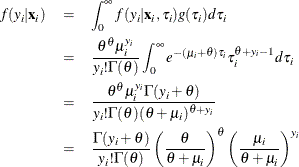The COUNTREG Procedure
- Overview
- Getting Started
-
Syntax
 Functional SummaryPROC COUNTREG StatementBAYES StatementBOUNDS StatementBY StatementCLASS StatementDISPMODEL StatementFREQ StatementINIT StatementMODEL StatementNLOPTIONS StatementOUTPUT StatementPERFORMANCE StatementPRIOR StatementRESTRICT StatementSCORE StatementSHOW StatementSTORE StatementWEIGHT StatementZEROMODEL Statement
Functional SummaryPROC COUNTREG StatementBAYES StatementBOUNDS StatementBY StatementCLASS StatementDISPMODEL StatementFREQ StatementINIT StatementMODEL StatementNLOPTIONS StatementOUTPUT StatementPERFORMANCE StatementPRIOR StatementRESTRICT StatementSCORE StatementSHOW StatementSTORE StatementWEIGHT StatementZEROMODEL Statement -
Details
 Specification of RegressorsMissing ValuesPoisson RegressionConway-Maxwell-Poisson RegressionNegative Binomial RegressionZero-Inflated Count Regression OverviewZero-Inflated Poisson RegressionZero-Inflated Conway-Maxwell-Poisson RegressionZero-Inflated Negative Binomial RegressionVariable SelectionPanel Data AnalysisBY Groups and Scoring with an Item StoreComputational ResourcesNonlinear Optimization OptionsCovariance Matrix TypesDisplayed OutputBayesian AnalysisPrior DistributionsAutomated MCMC AlgorithmOUTPUT OUT= Data SetOUTEST= Data SetODS Table NamesODS Graphics
Specification of RegressorsMissing ValuesPoisson RegressionConway-Maxwell-Poisson RegressionNegative Binomial RegressionZero-Inflated Count Regression OverviewZero-Inflated Poisson RegressionZero-Inflated Conway-Maxwell-Poisson RegressionZero-Inflated Negative Binomial RegressionVariable SelectionPanel Data AnalysisBY Groups and Scoring with an Item StoreComputational ResourcesNonlinear Optimization OptionsCovariance Matrix TypesDisplayed OutputBayesian AnalysisPrior DistributionsAutomated MCMC AlgorithmOUTPUT OUT= Data SetOUTEST= Data SetODS Table NamesODS Graphics -
Examples

- References
The Poisson regression model can be generalized by introducing an unobserved heterogeneity term for observation i. Thus, the individuals are assumed to differ randomly in a manner that is not fully accounted for by the observed covariates. This is formulated as
where the unobserved heterogeneity term ![]() is independent of the vector of regressors
is independent of the vector of regressors ![]() . Then the distribution of
. Then the distribution of ![]() conditional on
conditional on ![]() and
and ![]() is Poisson with conditional mean and conditional variance
is Poisson with conditional mean and conditional variance ![]() :
:
Let ![]() be the probability density function of
be the probability density function of ![]() . Then, the distribution
. Then, the distribution ![]() (no longer conditional on
(no longer conditional on ![]() ) is obtained by integrating
) is obtained by integrating ![]() with respect to
with respect to ![]() :
:
An analytical solution to this integral exists when ![]() is assumed to follow a gamma distribution. This solution is the negative binomial distribution. When the model contains a
constant term, it is necessary to assume that
is assumed to follow a gamma distribution. This solution is the negative binomial distribution. When the model contains a
constant term, it is necessary to assume that ![]() in order to identify the mean of the distribution. Thus, it is assumed that
in order to identify the mean of the distribution. Thus, it is assumed that ![]() follows a gamma(
follows a gamma(![]() ) distribution with
) distribution with ![]() and
and ![]() ,
,
where ![]() is the gamma function and
is the gamma function and ![]() is a positive parameter. Then, the density of
is a positive parameter. Then, the density of ![]() given
given ![]() is derived as
is derived as

Making the substitution ![]() (
(![]() ), the negative binomial distribution can then be rewritten as
), the negative binomial distribution can then be rewritten as
Thus, the negative binomial distribution is derived as a gamma mixture of Poisson random variables. It has conditional mean
and conditional variance
The conditional variance of the negative binomial distribution exceeds the conditional mean. Overdispersion results from
neglected unobserved heterogeneity. The negative binomial model with variance function ![]() , which is quadratic in the mean, is referred to as the NEGBIN2 model (Cameron and Trivedi, 1986). To estimate this model, specify DIST=NEGBIN(p=2) in the MODEL statement. The Poisson distribution is a special case of
the negative binomial distribution where
, which is quadratic in the mean, is referred to as the NEGBIN2 model (Cameron and Trivedi, 1986). To estimate this model, specify DIST=NEGBIN(p=2) in the MODEL statement. The Poisson distribution is a special case of
the negative binomial distribution where ![]() . A test of the Poisson distribution can be carried out by testing the hypothesis that
. A test of the Poisson distribution can be carried out by testing the hypothesis that ![]() . A Wald test of this hypothesis is provided (it is the reported t statistic for the estimated
. A Wald test of this hypothesis is provided (it is the reported t statistic for the estimated ![]() in the negative binomial model).
in the negative binomial model).
The log-likelihood function of the negative binomial regression model (NEGBIN2) is given by

if y is an integer. See Poisson Regression for the definition of ![]() .
.
The gradient is
and
Cameron and Trivedi (1986) consider a general class of negative binomial models with mean ![]() and variance function
and variance function ![]() . The NEGBIN2 model, with
. The NEGBIN2 model, with ![]() , is the standard formulation of the negative binomial model. Models with other values of p,
, is the standard formulation of the negative binomial model. Models with other values of p, ![]() , have the same density
, have the same density ![]() except that
except that ![]() is replaced everywhere by
is replaced everywhere by ![]() . The negative binomial model NEGBIN1, which sets
. The negative binomial model NEGBIN1, which sets ![]() , has variance function
, has variance function ![]() , which is linear in the mean. To estimate this model, specify DIST=NEGBIN(p=1) in the MODEL statement.
, which is linear in the mean. To estimate this model, specify DIST=NEGBIN(p=1) in the MODEL statement.
The log-likelihood function of the NEGBIN1 regression model is given by

See the section Poisson Regression for the definition of ![]() .
.
The gradient is
and